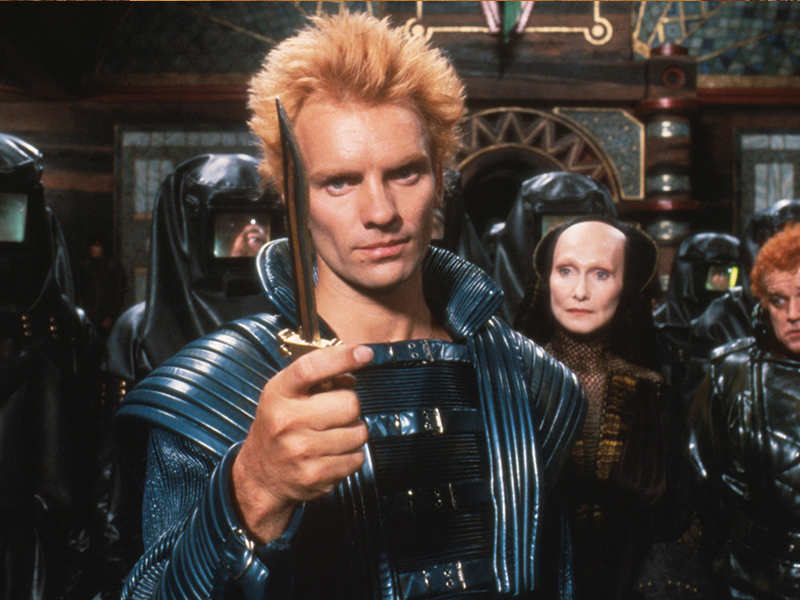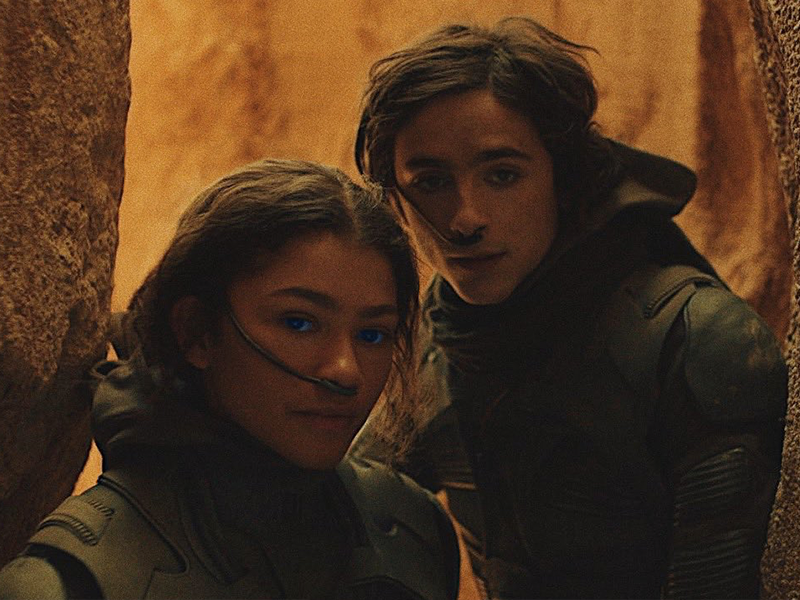Dune – Haunting predecessors
Villeneuve’s Dune is being launched 37 years after David Lynch’s attempt (a colossal distance in which no other director set his hands on this novel to adapt it) and, despite the technological gap in between them, these two films similarly approach the source material to such a degree that a lot of the uninitiated thought that this year’s feature was a remake of Lynch’s “original”. I wouldn’t be as harsh: I’d say that Villeneuve acts out of sympathy towards Herbert also as a way to find a mellow solution for the fans that would have been offended had he deviated too much from his story. Lynch had instead deviated in terms of visuals and representation, lining his film with a sweetened mosaic of anachronisms (Kyle MacLachlan is enthusiastically Cooperian, which turns him into an ideal white savior; need I mention the fact that he is hugging the Atreides family pug, that the characters’ shields are literally some shameless CGI cubes, that, in a moment of psychedelic delirium, we witness a Malickian Big Bang after Paul and Chiani kiss?).

Just as is the case with this universe’s protagonist, Villeneuve’s Dune lies under the crushing weight of a messianic mission – Herbert’s novel was a massive influence on George Lucas’ manner of constructing science fiction and remained a gestating project awaiting any filmmaker who would dare to approach it. I must remind you that Alejandro Jodorowsky abandoned filmmaking for decades after his mammoth project, which was hanging on a single concession, was rejected by Hollywood studios due to its massive runtime: 14 uninterrupted hours. (The concession was the following: the Emperor was to be performed by Dali, and since Dali was insisting on having the highest salary in Hollywood, Jodo planned to make a cast impression of him and construct a talking statue in his likeness) It might just be that such auteurist ambitions were the ones to nip all of the previous Dune-related projects in the bud, and as such, Villeneuve’s film is also pretty jarring, coming across as little more than a broad, sterile, and slow overture of the Canadian director’s mannerism (repetitive and obsessive frames of the vast of the desert, slow-motion shots featuring Paul Atreides’ hallucinogenic dreams, his fetish for ovaloid spaceships). In an interview for the New York Times, the director himself half-jokingly says that he would have adapted Dune just for the sake of shooting in the desert again. The information that Dune 2021 is but a part of an entire project that is underway wouldn’t necessarily be a tragedy – the problem with this is that anyone who is even vaguely familiar with the Dune universe knows that this first part barely condenses half of Herbert’s first volume and doesn’t have a self-sustaining finale, but rather ends on a cliff-hanger; taken at face value, he doesn’t get to say anything about the specters of colonialism, it eliminates weighty characters out of the picture or schematizes them outright. For a film of this magnitude, I think the fact that it leaves this entire task on the shoulders of the next installment is problematic.

In short, for Villeneuve, Dune is a sort of intergalactic coming of age story: Paul (performed by Timothée Chalamet) is the son of Duke Leto, the leader of the House of Atreides (Oscar Isaac), and his concubine, Jessica (Rebecca Ferguson), part of Bene Gesserit (a highly powerful matriarchy that is in cahoots with the Empire, hoping to give birth to a messiah into the world, a Kwisatz Haderach, a narration which also serves as a local superstition for the natives of Arrakis, the Fremen, who are waiting for a savior). The Duke has a mortal enemy in Baron Harkonnen (Stellan Skarsgard), who has been controlling the planet of Arrakis for decades, exploiting the world’s most costly luxury, a psychedelic spice that enables inter-spatial traveling. The Emperor finally allows the Atreides family to mine the spice, temporarily ousting the Harkonnens. However, after arriving on the planet, and despite their wish to come close to the natives by assuring them that they will no longer suffer exploitation, the Atreides are soon overwhelmed by a military plot that they cannot cope with. Paul has prophetic dreams which show him the way and the future (the Kwisatz Haderach is capable of ruling over the past, present, and future), especially his mission to be alongside the Fremen. In Lynch’s case, the love story between him and Chiani is a romantic continuation of the love shared by Jessica and Leto – for Villeneuve, these relationships are rendered but briefly, as Chiani (Zendaya) barely gets to know Paul before the end credits start to run. Another notable difference lies in the way in which the Harkonnens are depicted – if, in the 1984 film, they were rotund and redheaded, pimply and prone to playfully torture their enemies, for Villeneuve they are sybaritic behemoths, who partly live their lives in the clandestine atmosphere of their palaces (a sort of gothic, morbid reminiscence of Giger’s vision for Jodorowsky’s film), where they excessively feast upon meats and occasionally levitate.

Dune opens on Chiani’s anti-colonial speech, a monologue regarding the invaders who have overrun her lands – the point of view of the colonized populations – wherein the colonizers are regarded as barbaric conquerors, who impose military force. In a way, the intro promises that this story will change the rule of Herbert’s game and that it will tell the story from the perspective of those who do not have a hold on power – even so, shortly afterward, it becomes clear that this will be Paul’s story, and Chiani will only appear as a mere prophetic hallucination. Chiani is the red thread that guides the story about the Kwisatz Haderach and functions simultaneously as an insurance of the fact that, despite reproducing western ideals about power and civilizing missions, Dune’s super-hero is disinterested in power, and he is just a bridge between worlds. The anti-colonialist factor was an integral part of Herbert’s intentions in the novel, even if it was nestled between so many other problematic concepts (one of them being eugenics, the belief in a white savior born in a privileged caste, the second being the romanticization of the Fremen, seen either as colonized, helpless and preyed upon, either as hyper-evolved savages that are hard to control). All things considered, despite his attempts at making them come across as approachable, Villeneuve doesn’t stray far from the exoticism of the source-material – and here I cite a sequence in which the Fremens’ representative greets the Duke by spitting, and the Duke ashamedly replies in the same manner; in the film, it’s unclear why the Duke is so enthusiastic in his defense of the Fremen, and it’s also unclear why the Duke had such a strong wish to come to Arrakis if he didn’t care about the spice. It might just be that these suspicions and narrative gaps present in this first part become clearer once the second one is released (or maybe not, who knows?); however, Villeneuve is guilty of an all-too-grand ambition that prioritizes visual monumentalism instead of the political and social logic of this universe – the orb-shaped entrances of its cavernous interiors, the obsession for wood in the set design, the dusty light of the sets, and, last but not least, the planes – winged aircraft similar to dragonflies, which rise from the earth by batting their wings. Hans Zimmer’s musical score renders things even more somber and cavernous than they already are – the only thing that stays behind with me is an image that saves this film from being an utter morgue, that of a pointy-eared mouse who is squeaking in the broadness of the desert.
Title
Dune
Director/ Screenwriter
Jon Spaihts, Eric Roth, Denis Villeneuve
Actors
Timothée Chalamet, Rebecca Ferguson, Oscar Isaac, Zendaya
Country
SUA
Year
2021
Distributor
Vertical Entertainment
Journalist and film critic, with a master's degree in film critics. Collaborates with Scena9, Acoperișul de Sticlă, FILM and FILM Menu magazines. For Films in Frame, she brings the monthly top of films and writes the monthly editorial Panorama, published on a Thursday. In her spare time, she retires in the woods where she pictures other possible lives and flying foxes.


